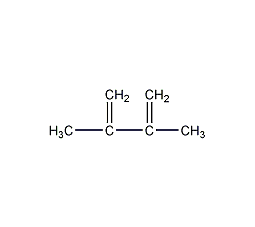
Structural formula
| Business number | 05AZ |
|---|---|
| Molecular formula | C6H10 |
| Molecular weight | 82.15 |
| label |
CH2=C(CH3)C(CH3)=CH2 |
Numbering system
CAS number:513-81-5
MDL number:MFCD00008595
EINECS number:208-172-0
RTECS number:None
BRN number:605285
PubChem number:24864689
Physical property data
1. Properties: colorless liquid
2. Density (g/ cm3, 25/4℃): 0.727
3. Liquid Phase standard heat of combustion (enthalpy) (kJ·mol-1): -3804.35
4. Melting point (ºC): -76
5. Boiling point (ºC, normal pressure): 68-69
6. Liquid phase standard claims heat (enthalpy) (kJ·mol-1): 14.14
7. Refractive index: 1.438
8. Flash point (ºF): -8
9. Liquid phase standard hot melt (J·mol-1 ·K-1): 180.1
10. Gas phase standard combustion heat (enthalpy) (kJ·mol-1): -3835.31
11. Gas phase standard claimed heat (enthalpy) (kJ·mol-1): 45.10
12. Gas phase standard entropy (J·mol-1 ·K-1): 340.41
13. Gas phase standard free energy of formation (kJ·mol-1): 148.7 p>
14. Gas phase standard hot melt (J·mol-1·K-1): 126.5
15. Critical pressure ( KPa): Undetermined
16. Log value of oil-water (octanol/water) partition coefficient: Undetermined
17. Explosion upper limit (%, V/V): Undetermined
18. Lower explosion limit (%, V/V): Undetermined
19. Solubility: soluble in water
Toxicological data
None yet
Ecological data
This substance may be harmful to the environment, and special attention should be paid to water bodies.
Molecular structure data
1. Molar refractive index: 28.98
2. Molar volume (cm3/mol): 117.3
3. Isotonic specific volume (90.2K ): 241.2
4. Surface tension (dyne/cm): 17.8
5. Dielectric constant (F/m): 2.13
6. Extreme Chemical rate (10-24cm3): 11.48
Compute chemical data
1. Reference value for hydrophobic parameter calculation (XlogP): 3.1
2. Number of hydrogen bond donors: 0
3. Number of hydrogen bond acceptors: 0
4. Number of rotatable chemical bonds: 1
5. Number of tautomers: none
6. Topological molecule polar surface area 0
7. Number of heavy atoms: 6
8. Surface charge: 0
9. Complexity: 66
10. Number of isotope atoms: 0
11. ConfirmNumber of atomic stereocenters: 0
12. Uncertain number of atomic stereocenters: 0
13. Determined number of chemical bond stereocenters: 0
14. Number of uncertain chemical bond stereocenters: 0
15. Number of covalent bond units: 1
Properties and stability
Use and store according to specifications, no decomposition will occur, and avoid contact with oxides
Storage method
Stored in a cool, dry and well-ventilated warehouse. Keep away from fire and heat sources. Protect from direct sunlight. The packaging is sealed. They should be stored separately from acids and food chemicals, and avoid mixed storage. Suitable materials should be available in the storage area to contain spills.
Synthesis method
1. Obtained from pinacol (tetramethylethylene glycol) catalyzed by hydrobromic acid dehydration. Slowly heat pinacol and 48% hydrobromic acid, and collect the distillate until it reaches 95°C. Take the supernatant liquid and wash it with water containing a small amount of hydroquinone, dry it with anhydrous calcium chloride, and then fractionate it to obtain the finished product.
2. Preparation method:
 Add 177g (1.5mol) of dry pinacol (2), 5mL azeotropic hydrobromic acid (47% ~ 48%), and a few grains of zeolite into the reaction bottle. Install a higher-efficiency fractionating column, and install a condenser and receiving device on the fractionating column. Heat the reaction bottle in an oil bath and control the elution speed to about 20 to 30 drops per minute. Slowly collect the distillate until the temperature at the top of the fractionation column reaches 95°C, which takes about 1 hour. Separate the upper layer of the distillate species and wash it twice with water. Add 0.25g of phenol as a polymerization inhibitor, and dry with anhydrous calcium chloride overnight. Fractionate, collect the fractions between 69 and 70.5°C ①, and obtain 70g of 2,3-dimethyl-1,3-butadiene ② (1), yield 57 %. Note: ① During distillation , the final fraction at 105-106°C is collected, which is pinacolone, about 35g. ② The product is easy to polymerize, so about 0.3% phenol should be added as a polymerization inhibitor, and it should be sealed and stored at low temperature. [1]
Add 177g (1.5mol) of dry pinacol (2), 5mL azeotropic hydrobromic acid (47% ~ 48%), and a few grains of zeolite into the reaction bottle. Install a higher-efficiency fractionating column, and install a condenser and receiving device on the fractionating column. Heat the reaction bottle in an oil bath and control the elution speed to about 20 to 30 drops per minute. Slowly collect the distillate until the temperature at the top of the fractionation column reaches 95°C, which takes about 1 hour. Separate the upper layer of the distillate species and wash it twice with water. Add 0.25g of phenol as a polymerization inhibitor, and dry with anhydrous calcium chloride overnight. Fractionate, collect the fractions between 69 and 70.5°C ①, and obtain 70g of 2,3-dimethyl-1,3-butadiene ② (1), yield 57 %. Note: ① During distillation , the final fraction at 105-106°C is collected, which is pinacolone, about 35g. ② The product is easy to polymerize, so about 0.3% phenol should be added as a polymerization inhibitor, and it should be sealed and stored at low temperature. [1]
Purpose
Used in the manufacture of synthetic rubber and polymers.


